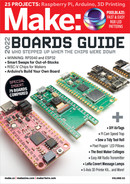
The past few years have been … unprecedented.
Supply chain failures manifest themselves visibly
around us, from parking lots in Detroit full of cars
that can’t be finished for lack of a single part, to
immense backlogs of container ships at the Port
of Long Beach. From consumers all the way up
to foundries, it feels like no part of the electronics
supply chain has escaped the impact of material
shortages and logistical quandaries.
We reached out to folks in the various strata of
the maker community to hear their stories, how
they’ve been impacted, and what the future looks
like from their vantage point.
KEY SUPPLIERS
Digi-Key Electronics started out as makers
themselves, and have grown over the past five
decades to become one of the world’s largest
distributors of electronic components. Today they
supply parts for prototyping and production to
everyone from the novice maker to some of the
largest engineering companies on the planet.
But even at this level — or perhaps particularly
at this level — supply chain issues can hit hard.
In the past, the world at large has occasionally
disrupted the world of components — the Great
Recession of the late 2000s, the odd run on
Raspberry Pis or ATmega328 DIPs — but during
this latest shortage Digi-Key has been continually
unable to attain their desired stock levels for
many high-running parts. Not just silicon either,
but connectors, and even some passives like SMT
capacitors.
Paradoxically these shortages have often
resulted in an increase in sales, as board
designers over-buy instead of assuming parts
will be available for the next re-spin. While the
RP2040 chip has gained huge traction with
makers, larger and more conservative customers
have stuck with, for example, STMicro chips, but
from different silicon suppliers. When even those
suppliers weren’t able to come through, Digi-Key
ran into a unique issue: their systems aren’t built
to handle three-digit-month lead times!
Despite the tension between supply and
demand, Digi-Key have been able to keep prices
relatively stable for customers — it would be easy
to tack $10 onto each Raspberry Pi when they do
get more in stock, but with an eye on long-term
(Figure
A
).
relationships Digi-Key are doing everything in
their power to help customers out. Thankfully,
however, from their perspective the pinch is
starting to plateau — and may slowly improve
in 2023. Innovation isn’t going away, nor are the
fundamentals of electronics — more fabs will be
created, but it takes time for the fruits of their
efforts to trickle down the chain.
HERO D’ITALIA
Even the mighty of the maker macrocosm are
unable to avoid the impact of shortages. At their
annual celebration in March, Arduino showed off
a number of new products and projects, only to
disclose uncomfortably that the featured board
was out of stock or unavailable.
The company informs us that they’d planned
to announce even more products but chose not
to, due to their inability to get them produced.
Furthermore, they’re reworking some existing
products to eliminate dependence on hard-to-find
parts.
Consequently, the inability to source parts
has caused a sea change in Arduino’s product
37
make.co
Keith Hammond, Adobe Stock-arthead, Kevin Walseth
M83_036-41_SS_ScarceChips_F1.indd 37M83_036-41_SS_ScarceChips_F1.indd 37 10/10/22 1:25 PM10/10/22 1:25 PM
..................Content has been hidden....................
You can't read the all page of ebook, please click here login for view all page.
